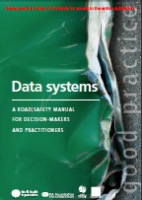Beberapa publikasi GRSP yang belum diterjemahkan:
Data systems: a road safety manual for decision-makers and practitioners (2010)
The fifth good practice manual jointly prepared by WHO, GRSP, the World Bank, and the FIA Foundation focuses on data systems for road safety. Reliable and accurate data are needed for a variety of purposes, including for advocating for road safety, identifying specific problems and risks, setting targets, formulating appropriate strategies and monitoring impact. Road safety data, collected every day in most countries, cannot meet these objectives unless they are properly coded, entered in a system, processed, analysed, disseminated and used.
This manual provides practical guidance for establishing data systems that will improve measurement of a country’s road traffic injury problem, facilitate selection of evidence-based interventions, and allow for better evaluation of progress. It discusses the use of such data systems to develop policies and interventions and to assess prevention measures.
The manual presents a conceptual framework for data-led road safety management and presents steps for assessing the availability and quality of existing road safety data. It offers guidance both for making improvements to existing road crash data systems, and for the design and implementation of a new road crash data system.
While stressing the importance of comprehensive data systems that cover not only deaths and injuries from road traffic crashes, but also exposure measures, intermediate outcomes and social costs, the manual acknowledges that most countries are struggling simply to establish quality data systems to document deaths and injuries. The practical guidance related to improving data quality and to improving the effectiveness of data systems therefore focuses mainly on data related to deaths and injuries—and more specifically, on the implementation of a crash database derived from police records. A minimum data set and accompanying definitions for such a database is proposed.
Down load versi Inggris 1,39Mb
Seat-belts and child restraints: a road safety manual for decision-makers and practitioners (2009)
Officially launched on 6 February 2009, the fourth in this series of good practice manuals, jointly prepared by the FIA Foundation for the Automobile and Society, the Global Road Safety Partnership, the World Bank and WHO, focuses on seat-belts and child restraints. The launch event was held in Costa Rica in the presence of the country’s Transport Minister, Karla Gonzalez; former Formula One driver, Michael Schumacher; and Make Roads Safe Campaign Ambassador, Michelle Yeoh.
Failure to use a seat-belt is a major risk factor for road traffic deaths and injuries among vehicle occupants. Passengers who are not wearing seat-belts at the time of a collision account for the majority of occupant road traffic fatalities.
The manual is a practical guide to implementing, enforcing and evaluating seat-belt and child restraint programmes, and consists of a series of ‘how to’ modules. It provides evidence of why the use of seat-belts and child restraints is important and takes the users through the steps needed to assess the situation in their own countries. It then explains the steps needed to design, plan and implement a seat-belt and child restraint programme. Finally, the manual guides users on how to monitor and evaluate such programmes so that the results can be fed back into programme design. For each of these activities, the document outlines in a practical way the various steps that need to be taken.
Download versi English [pdf, 3.3Mb]


